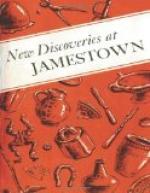Brick Walks or Paved Areas
It is difficult to assign a use for certain areas which have been paved apparently with brick rubble, or, in more evident cases, by flatlaid bricks. Four such paved areas have been discovered.
Brick Drains
Three brick drains, buried beneath the humus line, are identified with 17th-century houses.
Ice Storage Pit
So far unique on Jamestown Island is a circular unlined pit, 14 feet in top diameter, excavated 7 feet into a sandy substratum, and corresponding in general character to known 17th-and 18th-century ice pits in England. This pit which lies 250 feet east of the Visitor Center may have served a spacious house which once stood nearby. It may be assumed that the missing surface structure was circular, probably of brick, had a small door, and was roofed over with thatch or sod for insulation.
Kilns
Both brick and lime kilns are present in the “James Citty” area, each type being represented by four examples. The oldest of four brick kilns so far discovered on the island is a small rectangular pit near Orchard Run, excavated to a floor depth of 4 feet, which has been dated between 1607 and 1625 by associated cultural objects. This small pit, without structural brick, was a brick-making “clamp,” consisting of unfired brick built up over two firing chambers. There is good evidence that a pottery kiln was situated 30 feet west of the “industrial area.”
Ironworking Pits
Also in the “industrial area” near Pitch and Tar Swamp, there is a circular pit in which lime, bog iron, and charcoal suggest the manufacture of iron. The previously mentioned pit within the area of the Confederate Fort yielded sword parts, gun parts, bar iron, and small tools, indicating a forge site, perhaps an armorer’s forge.
[Illustration: Making pottery at Jamestown. (Conjectural sketch by Sidney E. King.)]
[Illustration: How an ironworking pit was used. (From contemporary sources.)]
[Illustration: Cross section of A brick-cased well at Jamestown. (Conjectural sketch by Sidney E. King.)]
[Illustration: One of the intriguing mysteries of Jamestown is how the left leg and left half of A human pelvis came to be thrown with other refuse into A well behind the row house. The logical inference is that A Rebel or criminal had been hanged, drawn, and quartered.]




